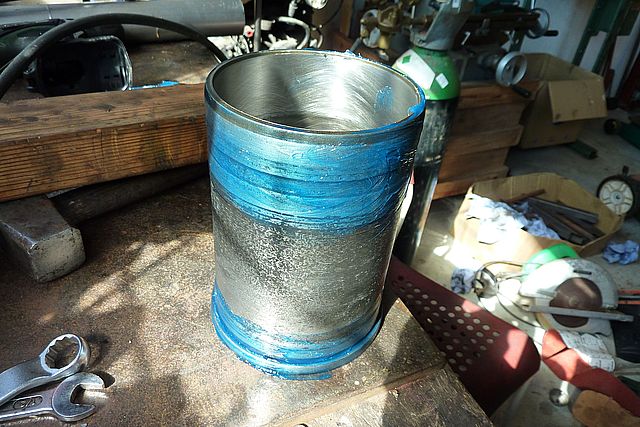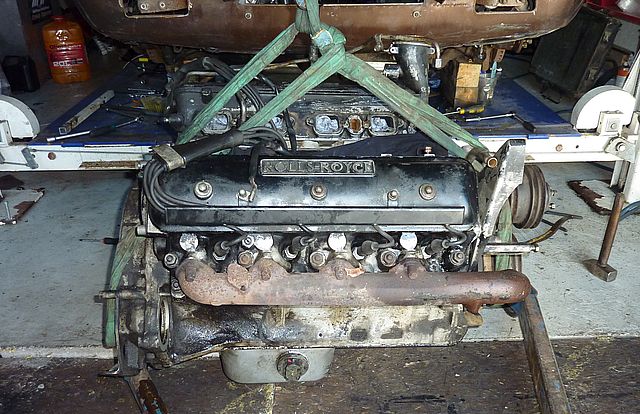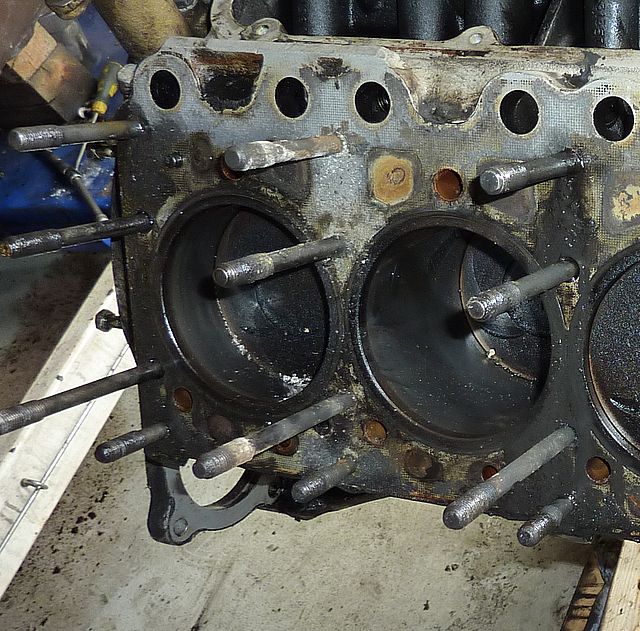| Author | Message | ||
Michael Jansberg Yet to post message Username: mikemjp Post Number: 1 Registered: 05-2021 |
Of course, first post and I chose the wrong forum, should've been about Shadows, well since the engine is the same I guess it doesn't matter too much.  Michael - no need to apologise, easy problem for me to fix. Have transferred this thread to the Silver Shadow Topic. BTW - Excellent job and thank you for taking the time to post this thread for the benefit of our members. David Me and the misses 75 Shadow project probably have all the faults that 20 years of storage and a couple of restoring attempts along the way by former owners can cause. On the positive side, the low mileage engine had hardly any wear on bearings, pistons etc. Stupidest thing I found was somebody along the way had refitted the gear selector arm, without fitting the oil seal! No wonder that the guy we bought it from couldn't make it move. At least a TH400 renovation kit from Summit was cheap and the box as other US boxes is easy to work on. I pulled the engine mainly because of a leaking tell tale hole behind the accumulators. Heating the block after soaking it with penetrating oil and using Kelly's super puller, I got the liners out without the bottom O rings causing trouble, but with more force needed than expected.  Lots of scale as expected, but sadly there were cracks on both sides of cyl. 6 (pic is of another cyl.)  I hand milled U shaped grooves down as close to the bottom O ring groove as I dared. In retrospect I would have milled a bit deeper, since the O ring grooves were easier to restore than expected.   TIG welded it with a 5% magnesium alloyed wire starting at 130 amps AC, block preheated with the kerosene burner to about 100-120 deg Cels. The clean milled metal in the groove welded nice and correctly together with the TIG wire. The RR block is looking like a high silicon alloy, so a similar TIG wire should also work fine, but the 5%Mg is stronger and I expect it to able to stop the rest of the crack to develop further, also used some penetrating Loctite on the remaining cracks.  Groove etc. restored.  I set all the O rings in gasket silicone since the grooves even after thorough cleaning still had signs of corrosion.  Then ordinary bearing grease on the liners and over the O rings.   At last, the liners are back in again.  | ||
Alan Dibley Frequent User Username: alsdibley Post Number: 292 Registered: 10-2009 |
Michael, you are a hero. Alan D. | ||
Geoff Wootton Grand Master Username: dounraey Post Number: 2258 Registered: 05-2012 |
Superb work. How did you pull the engine - through the hood aperture with the radiator removed or did you lift the car body and remove the engine, transmission and subframe as a unit from below, as per the workshop manual. | ||
David Gore Moderator Username: david_gore Post Number: 3942 Registered: 04-2003 |
Michael, I also used the Summit T400 overhaul kit when I overhauled the transmission on DRH14434 - did it include the wave plate for the 1st gear clutch pack? This was a RR modification to give a smooth take up from rest. I had to purchase this from an after-market transmission parts supplier as it was not included in the Summit kit I purchased in the late 1990's. | ||
Kelly Opfar Frequent User Username: kelly_opfar Post Number: 261 Registered: 07-2004 |
Michael, that is very good information and very resourceful. Let us know if this solves the weepy weep hole problems. BritishToolWorks.com | ||
Michael Jansberg New User Username: mikemjp Post Number: 2 Registered: 05-2021 |
Alan. Hero, it certainly sounds a lot better than the more correct: ignorant first time RR buyer  Geoff. We removed the transmission first and then lifted the engine out as recommended on page E5 in the manual, but it certainly is a tight fit and doing it by lifting the car of the subframe sounds like a good idea. David. No it didn't contain the wave plate, when I did the transmission, I wasn't even aware of its existance. Much worse, because of the lacking fluid, the forward clutch was so burned, I had to cut it in a lathe and put an extra metal plate in. A few more pics. The crank plug O rings were completely flattened, could've caused some oil leakage.  Engine lifted out.  | ||
Jeff Young Frequent User Username: jeyjey Post Number: 438 Registered: 10-2010 |
Bravo! | ||
Mark Aldridge Frequent User Username: mark_aldridge Post Number: 733 Registered: 10-2008 |
Excellent work, I admire your courage. Removing the engine complete with exhaust manifolds is a bonus. They would be easier to remove with the engine out, than in the car. | ||
Omar M. Shams Grand Master Username: omar Post Number: 2132 Registered: 04-2009 |
Well done Michael. Great stuff and a useful piece of history for us to refer to in the future. | ||
Geoff Wootton Grand Master Username: dounraey Post Number: 2259 Registered: 05-2012 |
Thanks for sharing this Michael. Did you have any difficulty removing the cylinder heads? I have read the studs can corrode, practically "welding" the heads in place. | ||
Graham Phillips Frequent User Username: playtime Post Number: 407 Registered: 03-2019 |
G'day everyone,..... Well thats one way to get to plugs B3-B4 when you need to change them,... ;) Nice work though. Graham. | ||
Michael Jansberg New User Username: mikemjp Post Number: 3 Registered: 05-2021 |
Geoff. Only very little corrosion on two studs like the picture shows, so removing the heads were fairly easy, but if these studs are heavily corroded I can imagine that the heads will seem allmost like welded on. On this engine most of the stud holes in the head were filled with old tar black motoroil that had seeped past the nuts.  The tell tale hole leak.  | ||
Geoff Wootton Grand Master Username: dounraey Post Number: 2260 Registered: 05-2012 |
The studs look in very good condition. Thanks for all the info - I'm hoping I never need to remove the engine from my car but this information is really useful, just in case I have to at some time. | ||
Jeff Young Frequent User Username: jeyjey Post Number: 439 Registered: 10-2010 |
He he... almost makes you want to fill the stud holes with old engine oil on purpose. ;) | ||
Michael Jansberg New User Username: mikemjp Post Number: 4 Registered: 05-2021 |
I think coating the studs and inside the holes in the head with grease would be a good idea, oil could easily run in between gasket and surfaces before the nuts are torqued down. Began cleaning the heads yesterday, found out why the sparkplugs weren't properly seated on most cylinders, somebody must have run it with too short plugs for long enough time to cause so much carbon build up on bottom threads, that a tap was needed to clean the threads. | ||
ross kowalski Prolific User Username: cdfpw Post Number: 1536 Registered: 11-2015 |
Michael, Excellent work. Can't wait to see how this develops! | ||
richard george yeaman Prolific User Username: richyrich Post Number: 1163 Registered: 04-2012 |
Michael, I cant imagine myself having the courage to take on such a Mammoth task, I will watch with interest. Richard. | ||
Jeff Martin Frequent User Username: jeff_r_1 Post Number: 240 Registered: 07-2018 |
What a way to manufacture an engine ! Typical Rolls Royce true to form, making it needlessly complicated and difficult to work on and repair. If the block was solid cast iron, none of this would be a concern. There is no real advantage of making an engine this way. | ||
David Gore Moderator Username: david_gore Post Number: 3944 Registered: 04-2003 |
Jeff, Don't forget the R-R/B V8 engine was designed in the 1950's using technology and design features inherited from the WW2 Merlin V12 engine. The long production life for this engine is a testimony to its suitability and subsequent modification to meet the needs of later vehicles. The use of an aluminium block was essential for aircraft engines to keep dead weight to a minimum and subsequent experience in automotive applications revealed light-weight engines were very effective from a handling and performance perspective. The ratio of aluminium to cast iron engine blocks today is a testament to Rolls-Royce's foresight in preparing for the future IMHO. |